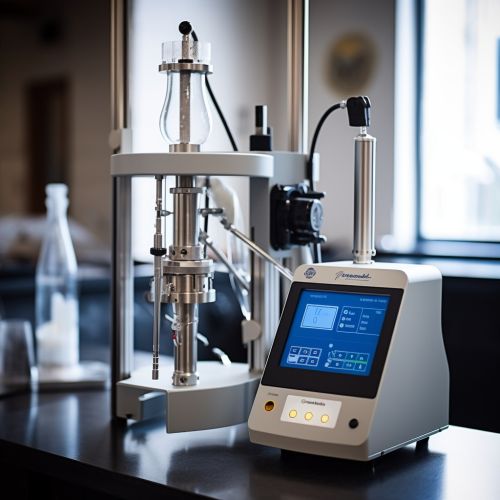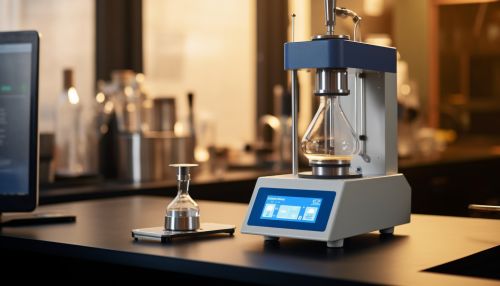Rheometer
Introduction
A Rheometer is a laboratory device used to measure the way in which a liquid, suspension or slurry flows in response to applied forces. It is used for those fluids which cannot be defined by a single value of viscosity and therefore require more parameters to be set and measured than is the case for a viscometer.
History
The first rheometer was developed by Eugene C. Bingham and Howard R. Crawford in 1922. It was a concentric cylinder device, with one cylinder rotating within another, and the fluid to be tested filling the gap between the two. This design is still in use today, although many other types of rheometer have been developed since then.


Types of Rheometers
There are several types of rheometers, each designed to measure different aspects of a fluid's rheological properties. These include:
Rotational Rheometers
Rotational rheometers measure the torque required to rotate a spindle at a set speed in a fluid. The resulting shear stress and shear rate can then be used to calculate the fluid's viscosity.
Capillary Rheometers
Capillary rheometers measure the pressure required to force a fluid through a small-diameter capillary at a set flow rate. This is used to determine the fluid's viscosity and shear stress.
Oscillatory Rheometers
Oscillatory rheometers apply a sinusoidal stress or strain to a fluid and measure the resulting strain or stress, respectively. This is used to determine the fluid's viscoelastic properties.
Extensional Rheometers
Extensional rheometers measure the extensional viscosity of a fluid, which is the resistance of a fluid to stretch or elongate.
Rheological Models
Rheological models are mathematical equations that describe the flow behavior of fluids. These models are used to predict how a fluid will behave under different conditions. Some of the most commonly used rheological models include:
Newtonian Model
The Newtonian model describes fluids that have a constant viscosity, regardless of the shear rate. This model is named after Sir Isaac Newton, who first proposed it.
Power Law Model
The Power Law model describes fluids whose viscosity decreases as the shear rate increases. This is common in non-Newtonian fluids.
Bingham Plastic Model
The Bingham Plastic model describes fluids that behave as a rigid body at low shear stresses but flow as a viscous fluid at high shear stresses.
Herschel-Bulkley Model
The Herschel-Bulkley model is a generalized model that includes both the Power Law and Bingham Plastic models as special cases.
Applications
Rheometers are used in a wide range of industries to measure the rheological properties of fluids. These include:
- The food industry, where rheometers are used to measure the viscosity and texture of products such as sauces, dressings, and dairy products. - The pharmaceutical industry, where rheometers are used to measure the flow properties of drug formulations. - The oil and gas industry, where rheometers are used to measure the flow properties of drilling fluids and to predict their behavior under different conditions. - The cosmetics industry, where rheometers are used to measure the viscosity and texture of products such as creams, lotions, and shampoos. - The construction industry, where rheometers are used to measure the flow properties of concrete and other building materials.
See Also
- Viscometer - Fluid dynamics - Non-Newtonian fluid - Viscosity
